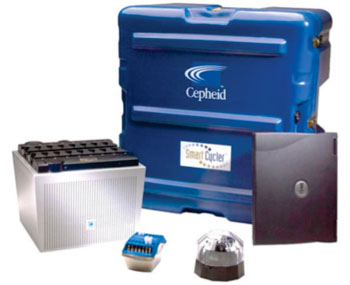Whole Blood DNA Extraction Methods Compared
By LabMedica International staff writers
Posted on 14 Aug 2014
In the clinical laboratory, nucleic acids are routinely isolated from various types of specimen, including blood, sputum, cerebrospinal fluid, stool, urine, buccal swabs, and respiratory specimens, for use in a wide array of molecular diagnostic tests.Posted on 14 Aug 2014
Both the quality and quantity of the extracted nucleic acids are crucial to the successful implementation of downstream molecular diagnostic procedures, including polymerase chain reaction (PCR), quantitative PCR, microarray analyses, and direct sequencing.

Image: The SmartCycler System for Real-Time Polymerase Chain Reaction (Photo courtesy of Cepheid).
Laboratory scientists at the Asian Medical Center (Seoul, Republic of Korea) collected blood samples from five healthy donors and all DNA extraction processes were performed within six hours of specimen collection. The team evaluated the efficiency of three extraction methods by comparison based on the total amount of extracted DNA adjusted by input blood volume, and the purity of the extract. Polymerase chain reaction analyses were performed using the Actin Beta gene (ACTB) as a target. The real-time PCR assay was carried out for housekeeping gene glyceraldehyde-3-phosphate dehydrogenase (GAPDH). Total elapsed time for DNA extraction was compared.
The three extraction methods were the Nextractor NX-48 system, (Genolution; Seoul, Republic of Korea); the manual QIAamp DNA Blood Mini Kit (Qiagen; Valencia, CA, USA), and the automated Maxwell system method (Promega; Madison, WI, USA). Following DNA extraction, the optical density of each sample was read at 260 nm and 280 nm using a NanoDrop ND-2000c spectrophotometer (Thermo Scientific; Wilmington, DE, USA). Real-time PCR was run on a SmartCycler system (Cepheid; Sunnyvale, CA, USA).
Extraction efficiencies for the QIAamp was 25.4 ± 3.8 ng/μL, for the Maxwell it was 9.2 ± 0.6 ng/μL, and the Nextractor system was the most efficient at 31.0 ± 5.6 ng/μL. No significant differences in purity were observed among three methods. DNA extracted using the ACTB was successfully amplified in all three methods. There were no obvious differences in cycle threshold (Ct) values for GAPDH real-time PCR. Total elapsed time for DNA extraction was about 50 minutes for the QIAamp, 40 minutes for the Maxwell, and 20 minutes for the Nextractor.
The authors concluded that both the purity and yield of the Nextractor system were similar to that of manual extraction. The relative speed and low hands-on time represent clear benefits over manual processes. Therefore, the Nextractor system represents a useful alternative to manual DNA extraction in clinical laboratories that is suitable for many downstream molecular diagnostic applications. The study was published in the August 2014 issue of the journal Clinica Chimica Acta.
Related Links:
Asian Medical Center
Genolution
Cepheid













